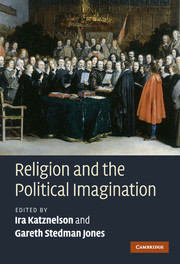Book contents
- Frontmatter
- Contents
- List of contributors
- Acknowledgements
- Introduction: multiple secularities
- 1 Secularisation: religion and the roots of innovation in the political sphere
- 2 Regarding toleration and liberalism: considerations from the Anglo-Jewish experience
- 3 The Enlightenment, the late eighteenth-century revolutions and their aftermath: the ‘secularising’ implications of Protestantism?
- 4 In the lands of the Ottomans: religion and politics
- 5 The Russian Orthodox Church and secularisation
- 6 The American experience of secularisation
- 7 French Catholic political thought from the deconfessionalisation of the state to the recognition of religious freedom
- 8 Religion and the origins of socialism
- 9 From 1848 to Christian Democracy
- 10 The disciplining of the religious conscience in nineteenth-century British politics
- 11 Colonial secularism and Islamism in North India: a relationship of creativity
- 12 The 1960s
- 13 Gendering secularisation: locating women in the transformation of British Christianity in the 1960s
- 14 Does constitutionalisation lead to secularisation?
- 15 Europe's uneasy marriage of secularism and Christianity since 1945 and the challenge of contemporary religious pluralism
- 16 On thick and thin religion: some critical reflections on secularisation theory
- Index
5 - The Russian Orthodox Church and secularisation
Published online by Cambridge University Press: 05 June 2012
- Frontmatter
- Contents
- List of contributors
- Acknowledgements
- Introduction: multiple secularities
- 1 Secularisation: religion and the roots of innovation in the political sphere
- 2 Regarding toleration and liberalism: considerations from the Anglo-Jewish experience
- 3 The Enlightenment, the late eighteenth-century revolutions and their aftermath: the ‘secularising’ implications of Protestantism?
- 4 In the lands of the Ottomans: religion and politics
- 5 The Russian Orthodox Church and secularisation
- 6 The American experience of secularisation
- 7 French Catholic political thought from the deconfessionalisation of the state to the recognition of religious freedom
- 8 Religion and the origins of socialism
- 9 From 1848 to Christian Democracy
- 10 The disciplining of the religious conscience in nineteenth-century British politics
- 11 Colonial secularism and Islamism in North India: a relationship of creativity
- 12 The 1960s
- 13 Gendering secularisation: locating women in the transformation of British Christianity in the 1960s
- 14 Does constitutionalisation lead to secularisation?
- 15 Europe's uneasy marriage of secularism and Christianity since 1945 and the challenge of contemporary religious pluralism
- 16 On thick and thin religion: some critical reflections on secularisation theory
- Index
Summary
In his study of religion in western Europe, Hugh McLeod claims that the nineteenth and twentieth centuries up to 1970 were a period not of secularisation but rather of polarisation, in which both Christianity and militant secularism were major forces in political, social and cultural life. As he sees it, three tendencies were in contention: (i) radical Protestantism; (ii) ultramontane Catholicism; (iii) the secular ‘religion of humanity’. I will argue that the equivalent of (ii) and (iii) were clearly present in Russia, and indeed that they conducted a bitter and mutually destructive war in the twentieth century. (i) was far less conspicuous, but many of the forces that generated Protestantism elsewhere were also active in Russia, and they stimulated the appearance of quasi-Protestant forms of religiosity, though without the cultural underpinnings that sustained Protestantism elsewhere in Europe.
An alternative way to look at religious evolution in Russia in the eighteenth and especially nineteenth centuries has been mooted by Christopher Bayly. Writing about the world as a whole, he suggests that secularisation was
only one small part of the reconstruction from within of the religious sensibility and of religious organisation … Almost everywhere in the world religions sharpened and clarified their identities, especially in the later nineteenth century. They expanded to try to absorb and discipline the variegated systems of belief, ritual and practice which had always teemed beneath the surface in the earlier ages of supposed religiosity.
- Type
- Chapter
- Information
- Religion and the Political Imagination , pp. 112 - 131Publisher: Cambridge University PressPrint publication year: 2010



